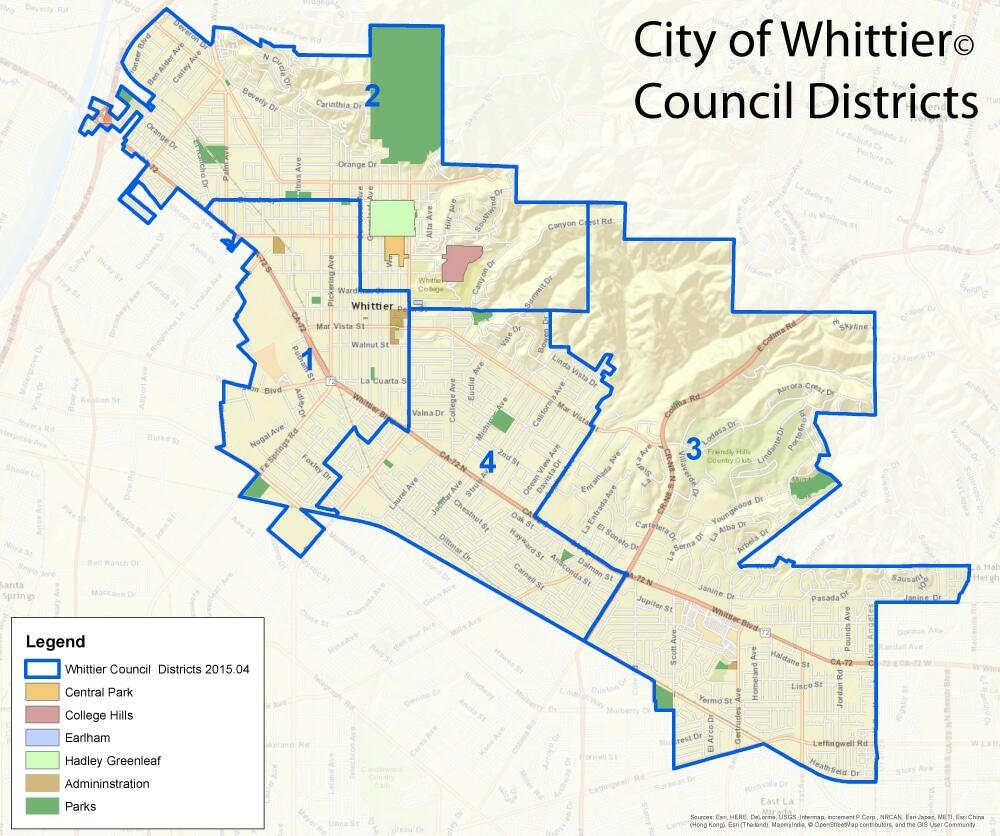Introduction
To plan community services, nurses need to reveal specific problems, assess the current situation, and identify resources available in a certain area. A windshield survey is an informal tool for observing a community and evacuating it from the points of housing, organization, transportation, ethnicity, and so on (Nies & McEwen, 2019). This paper aims to report the results of the windshield survey that is conducted for Whittier, CA. It is a city that was founded in 1989, while the recent estimates show that 88,078 people live there. The community is situated in the southeast of Los Angeles and designated as service planning area 7 (SPA 7).
Boundaries and Geographic Environment
Hacienda Heights, Santa Fe Springs, La Habra Heights, Pico Rivera, La Mirada, and Norwalk are the cities that border Whittier. Highway 5, Highway 605, Highway 10, and Highway 5 identify the boundaries as well. Whittier Boulevard divides the city into high-income (north) and low-income (south) communities. The high daily temperatures result from the fact that Whittier is located 15 mi inland of the Pacific Ocean. The thermal inversion leads to warm night-time lows, and Mediterranean patterns of rainfalls are prevalent during winter. The city area is regarded as 14.7 square miles, of which virtually all the territory is represented by land (Picture 1). Public transportation is well-developed in Whittier since there is a range of municipal buses, metro, student shuttles, and taxis.

Resources, Services, and Organizations
The city has significant health resources in various fields, including lung diseases, cancer, cardiovascular issues, diabetes, mental care, substance abuse, et cetera. While the Presbyterian Intercommunity Hospital (PIH) hospital is the key available healthcare resource, there are also Wesley Health Centers, AltaMed Medical and Dental Group, True Lasting Connections Family Resource Center, and a variety of assistance programs (“Community health needs assessment,” 2016). Brookdale Senior Living is another resource that is devoted to older adults who need to be assisted or independent living as well as mental health interventions. In terms of disease prevention, the local Parenthood Clinic and LA County Department of Public Health promotes immunizations and screening options.
Social and Education Services
Supportive and social services are also provided by PIH and its charitable mission that consists of financial assistance to underinsured persons and those who have a disadvantaged social status. This hospital develops a wide network of community partners and contributors who provide the necessary assistance. Education services are presented by the Head Start programs for preschool preparation, K-12 public schools, high schools, and adult education.
Religion and Spirituality
In addition, several faith-based private schools offer their services for Christian and Catholic families. The majority of Wittier residents are Christians, and Saint Matthias Episcopal Church serves temporary shelters, meals, and hygiene kits for people in need. The registered nurses and nurse practitioners work there as volunteers.
Race and Ethnicity
In 2017, the ethnic composition of Whittier was mainly composed of the White population (47,713) and Hispanics (61,494). The African-American population counts for 0.98% of the total population (1,375). Also, there are Asian, American Indian, Native Hawaiian, and some other races. The statistics show that Whittier is an ethnically diverse area.

Open Space and Options for Eating Out
Whittier’s recreation and community services include 23 parks, the UpTown Historic District, the Greenway Trail, and other options for walking and observing nature. A lot of walking, bike, and hiking trails serve as safe and engaging options for citizens to rest. In addition, Hellman Park and Trailhead, Turnbull Canyon, Sycamore Canyon Trail, and Arroyo Pescadero Trail also provide open spaces. The key aim of the city is to support flora and fauna and ensure visual beauty. The options for eating out are diverse and multiple, beginning with the national fast-food chains and ending with expensive restaurants.

Housing and Zoning
The City of Whittier Community Development and Planning Services is responsible for supporting the Zoning Code and City’s General Plan, regulating housing issues. Due to the rich history of Whittier, the houses built in the late 20th century and modern buildings are spread evenly across the area. The Friendly Hills neighborhood is marked by large houses and high-income families, while many traditional houses require repair. Condominiums, apartments, and townhouses are the most widespread types of living for low-income and middle-income populations. The racial division is also evident when it comes to zoning.
Condition of the Area and People in the Community
The low- and high-income areas are distinguished by their cleanliness and overall attractiveness. The high-income neighborhood had lawns, many trees, less traffic, and no homeless. On the contrary, low-income areas can be characterized by dirty and outdated facilities, graffiti, homeless, and abandoned furniture. During the windshield survey, a lot of people were walking on the streets, sitting on the benches, and speaking to each other. The families with children were playing outside, and several people were visiting cafes and shops. The community encounters significant challenges while helping the homeless population. Currently, the poverty rate is 12.1%, and the number of homeless is 245 persons. The Homeless Action Plan that is run by the Los Angeles Homeless Services Authority (LAHSA), strives to provide safety, cleanliness, and quality of living. Five homeless people were observed in the streets with their living facilities.
Employment
The city of Whittier integrates such largest industries as Health Care and Social Assistance, Education Services, and Manufacturing, each of which employs approximately 5,000 people. In general, the economy of the city offers 40,900 positions for employment. The gender-related wage disparity exists: while the average female remuneration of women is $ 57,252, men receive $ 72,235, and there are 126 times more male workers compared to females.

Wage distribution is also characterized by some discrepancy as Asians have $65,946, Whites – 59,295, and other ethnicities – less than $50,000 (“Whittier, CA,” 2017). Law Enforcement workers and Treating Practitioners are the most highly paid specialists. As reported by the US Census Bureau, 18% of households in the city face severe burdens, and another 42% have to handle housing burdens (Los Angeles County of Public Health, 2018). The median household income is estimated at $ 69,058.
Common Areas, Stores, and Shopping
Uptown Wittier is the main place with parks, stores, cinema, coffee shops, and restaurants. Public libraries, dog parks, a golf club, and Friendly Hills Country Club were noticed. The majority of Uptown Wittier visitors were students and adolescents, while parents with children were likely to prefer playgrounds and walking options. The Whittier Greenbelt trail seems to attract a lot of people to ride their bicycles. On the east side of the city, there is Sprout’s Farmers Market, Trader Joe’s, and Vons; on the west, Whittier Ranch Market, Vallarta Supermarkets, fast food chains, and liquor stores are noted.
Business and Industry
There are two shopping centers, both of which are situated in UpTown Whittier. The Quad shopping mall and the Whitewood Town Center offer customers various national brands, retail shops, and dining options. For example, TJ Maxx, Starbucks, Target, Kohl’s, Michaels, Chick-fil-A, and others – are all located in the mentioned place. More to the point, a range of small businesses can also be noted, including restaurants and coffee shops. It is expected that more businesses would come to the city.
Animal Control
In Dog Park, there is a special access system, and dogs can run without a leash and play freely with other dogs. The standard platform is equipped with benches for owners, bowls with water, stands with dog packages for waste disposal, and pet training facilities. The supervision of owners is required during the whole pastime to ensure the safety of pets and people. No homeless dogs were noticed during the city assessment, which is supported by the city authorities, which provide low-cost pet licenses and vaccines.
Media
The city of Whittier transmits information to its residents through traditional methods and online channels. The Whittier Daily News is the local newspaper that also has its online version for the convenience of the citizens. The official city website (www.cityofwhittier.org) contains the most updated and credible information. People also use social media to connect to each other and discuss problems and topics of interest. For example, Facebook, Instagram, Twitter, and Nextdoor are the most popular resources. Data about public events and activities is disseminated through billboards, emails, flyers, and brochures.
Health Indicators
Diabetes, obesity, and cardiovascular issues are the key health challenges faced by the residents of Whittier. In 2014, the rates of obesity were 39.3%, which exceeds the national goal for obesity reduction. The prevalence of diabetes increases steadily and composes 12.4%, and heart disease is marked by the rate of 6.1% (“Community health needs assessment,” 2016). People living on the west of Whittier with a lack of proper food, insurance, and liquor stores are most vulnerable (11.2% of diabetes and 39.3% of obesity cases). The levels of mortality with regard to all of the mentioned health indicators prevail over those of Los Angeles County and California. At the same time, the city receives fewer immunization vaccines, but it complies with senior pneumonia vaccination expectations. Mammograms and colorectal cancer screening rates increased within recent years, which shows a greater awareness of their importance among the population.
Community Health Diagnosis
The observation reveals many obese persons, some of which also have obese children. A lot of smoking people were standing near liquor stores and fast-food chains. It seems that obesity and diabetes are chronic conditions for this city’s residents, yet some attempts to improve the situation are evident. For example, accessible places for walking and biking, parks, and trails are available to everyone for free. One may suggest that the promotion of healthy lifestyles needs to be given greater attention from Whittier’s authorities, especially the health department. In addition, there is a need to make healthy food more affordable so that low-income families may also replace their fast food nutrition with a preferable option.
In general, the observed population and area characteristics are consistent with data published on official websites and other resources. It was revealed that the key health problems are correctly identified in the literature, and recreation opportunities are organized properly. The assets of the Whittier community include social and educational services, religious facilities, parks, trails, as well as health care efforts. Even though much to be done to enhance the health of the population, it is clear that practitioners and authorities work towards this direction. It seems that the feeling of safety depends on the geographical and economic areas: low-income neighborhoods may be characterized as uneven and even criminal.
Healthy People 2020
Healthy People 2020 sets specific goals for disease treatment and prevention in the US. Whittier does not meet the idea of reducing diabetes levels since this indicator remains growing (“Diabetes,” 2016). The city also exceeds the targeted rate of obesity (30.5) stroke mortality (34.8), failing to meet 70% flu shots (“Community health needs assessment,” 2016). The underlying interventions for achieving Healthy People 2020 are early diagnosis and lifestyle changes.
Conclusion
To conclude, this report presents the findings of the windshield survey conducted in Whittier, CA. It was revealed that the city is divided into low- and high-income areas, and the former are more prone to obesity and diabetes as well as have problems with healthy lifestyles. There are useful social and educational services, recreational zones, and accessible options for children. This community needs health promotion, disease prevention, and affordable healthy food initiatives.
References
Community health needs assessment. (2016). Web.
Diabetes. (2016). Web.
Los Angeles County of Public Health. (2018). City and community health. Web.
Nies, M. A., & McEwen, M. (2019). Community/public health nursing-e-book: Promoting the health of populations (7th ed.). St. Louis, MI: Elsevier Health Sciences.
Parks. (2017). Web.
Whittier, CA.(2017). Web.